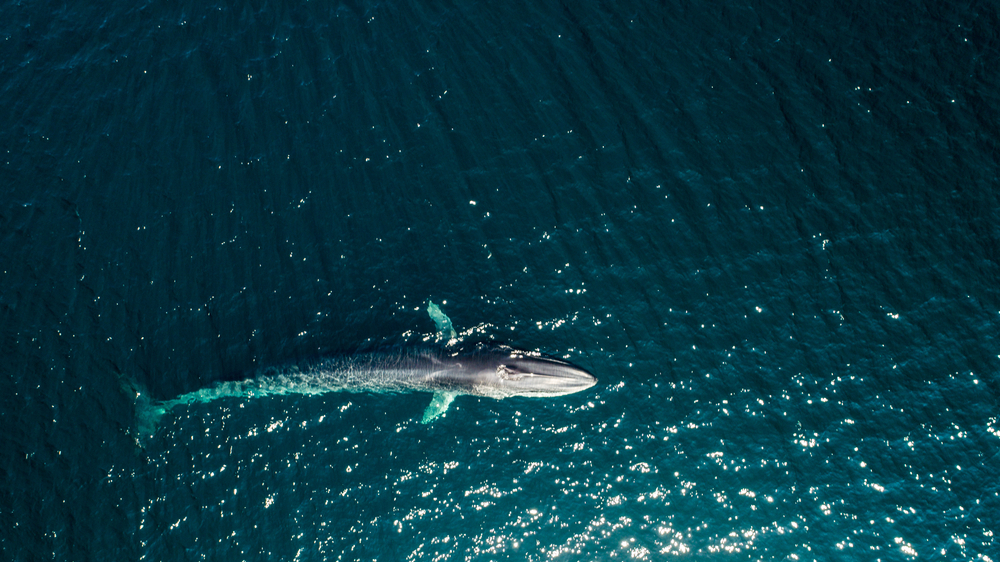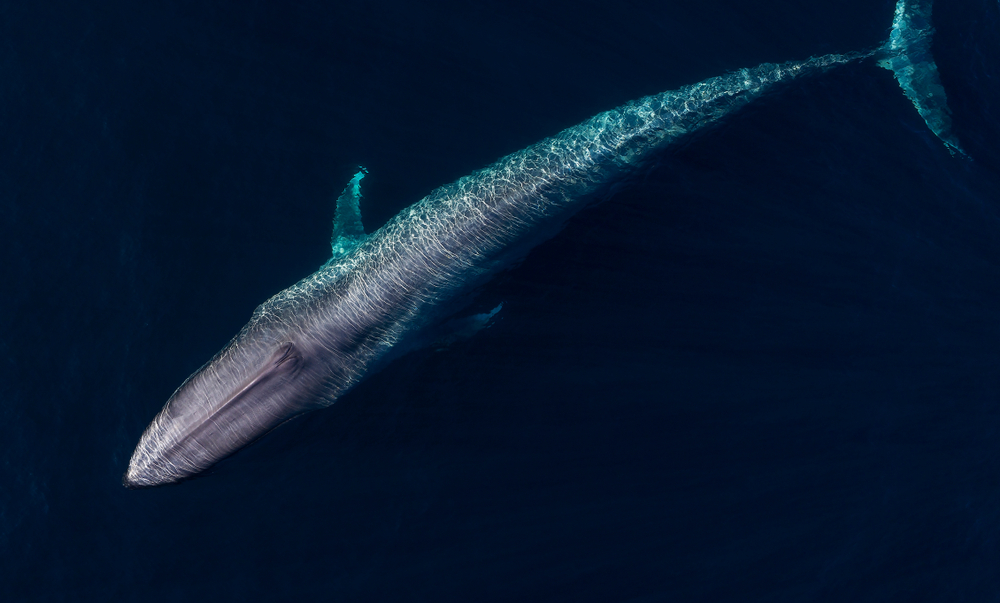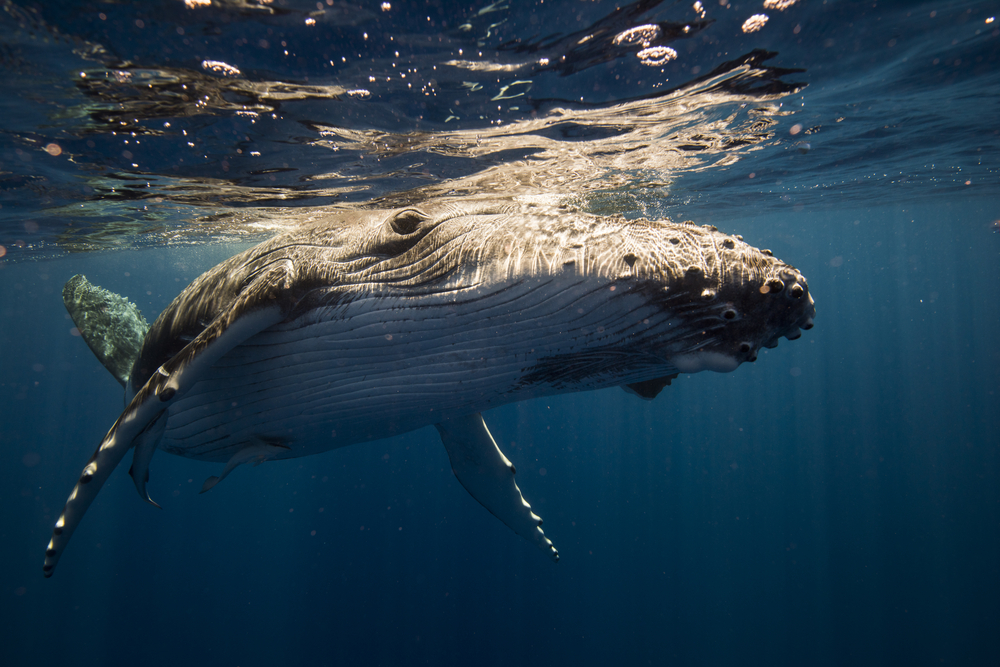The fin whale (Balaenoptera physalus) is most closely related to the blue whale (Balaenoptera musculus). Both species belong to the same genus, Balaenoptera, and share several physical and behavioral characteristics. They are often referred to as the “great whales” and are known for their impressive size and streamlined bodies.
About
The Fin Whale, scientifically known as Balaenoptera physalus, is a species of baleen whale within the Animal Kingdom’s class Mammalia and order Cetacea. It belongs to the Balaenopteridae family, which also includes other large whale species such as the blue whale and humpback whale. Fin Whales are found in oceans worldwide and are known for their streamlined bodies and impressive size.
These magnificent marine mammals are second only to the blue whale in size, with adults reaching lengths of up to 24 meters and weights of up to 80 metric tons. Fin Whales have a distinct body shape characterized by a long, slender body, a pointed snout, and a prominent dorsal fin located two-thirds down their back.
Fin Whales are highly migratory animals, undertaking extensive seasonal migrations between feeding and breeding grounds. They are primarily found in deep offshore waters, where they feed on small schooling fish such as herring, sardines, and krill, using their baleen plates to filter prey from the water.
Despite their large size, Fin Whales are known for their agility and speed, capable of reaching speeds of up to 37 kilometers per hour when swimming. They are also known for their haunting vocalizations, which can be heard over long distances underwater and are thought to be used for communication and navigation.
Conservation Concerns
Fin Whales face various conservation concerns, including habitat degradation, pollution, entanglement in fishing gear, and ship strikes. Historically, they were heavily targeted by commercial whaling, resulting in significant population declines.
While the International Union for Conservation of Nature (IUCN) Red List currently classifies the Fin Whale as an endangered species, there are ongoing efforts to protect and conserve their populations. Conservation measures include the establishment of marine protected areas, regulations on commercial whaling, and initiatives to reduce bycatch and ship strikes.
Continued research, monitoring, and international cooperation are essential for implementing effective conservation strategies to ensure the recovery and long-term survival of the Fin Whale and other marine mammal species
Physical Characteristics
The Fin Whale (Balaenoptera physalus), also known as the finback whale or razorback whale, is the second-largest species of whale after the blue whale. This streamlined and elegant giant of the sea is known for its speed and has been nicknamed the “greyhound of the sea.” Fin whales are found in all the world’s major oceans, from polar to tropical waters.
Size and Weight:
- Length: Adult fin whales can range from 59 to 86 feet (18 to 26 meters) in length, with females slightly larger than males, a characteristic common among baleen whales.
- Weight: They can weigh anywhere from 40 to 80 tons (36,287 to 72,575 kilograms), with some individuals reaching even greater weights.
Physical Characteristics:
- Body Shape: The fin whale has a sleek, streamlined body with a distinct ridge along its back behind the dorsal fin, contributing to its hydrodynamic efficiency. Its body is slender and elongated, allowing it to cut through the water with ease.
- Coloration: One of the most striking features of the fin whale is its color pattern. The whale’s right lower jaw is bright white, while the left side is dark. This asymmetry extends to the baleen plates as well. The rest of the body is predominantly dark grey to brownish-black, with a paler underside.
- Blowhole and Dorsal Fin: The fin whale has a single, crescent-shaped blowhole. Its dorsal fin is small and curved, located about two-thirds of the way back on the body, and it becomes visible soon after the blow when the whale is at the surface.
- Flippers and Tail: Its pectoral flippers are small and tapered, while the tail flukes are broad and triangular, with a notable notch in the middle. The tail is powerful, propelling the whale through water at high speeds.
- Baleen Plates: Like other baleen whales, fin whales have baleen plates instead of teeth, used for filter-feeding. These plates are dark grey or black and are used to strain small prey like krill and small fish from the water.
- Blow: The blow of a fin whale is tall and columnar, reaching up to 20 feet (6 meters) in height, and is a distinctive sight when the whale breathes at the surface.
- Vocalizations: Fin whales are also known for their vocalizations, which are among the loudest of any animal on Earth. They produce low-frequency sounds that can be used for communication and possibly for navigation and hunting in the ocean’s depths.
The Fin Whale’s impressive size and speed, along with its widespread distribution, make it an important species in marine ecosystems. Despite being heavily hunted during the whaling era, fin whales are slowly recovering in some areas, although they remain classified as vulnerable due to threats such as ship strikes and noise pollution. Their majestic presence in the oceans continues to fascinate and remind us of the need to protect these remarkable marine giants.
Reproduction
The reproductive cycle of the Fin Whale (Balaenoptera physalus) is characterized by specific stages that ensure the continuation of this majestic species:
- Mating and Courtship:
- Fin whales typically engage in mating behaviors during the winter months. While there is no strict breeding season, mating tends to peak in temperate and subtropical breeding grounds.
- Courtship may involve vocalizations, physical displays, and close swimming patterns among potential mates.
- Gestation:
- The gestation period for fin whales lasts approximately 11 to 12 months. This extended gestation ensures that calves are born developed enough to survive in the marine environment.
- Birth and Maternal Care:
- Fin whales usually give birth to a single calf, with twins being an extremely rare occurrence. At birth, calves are about 18 to 21 feet (5.5 to 6.5 meters) long and weigh approximately 4,000 to 6,000 pounds (1,800 to 2,700 kilograms).
- Calves are nursed on rich, fatty milk and may continue to do so for 6 to 7 months, during which they experience significant growth. The strong bond between the mother and calf is crucial for the calf’s development and survival.
- Infant Development:
- After weaning, the young whale continues to grow rapidly, staying close to its mother and learning essential survival skills.
- Sexual Maturity:
- Fin whales reach sexual maturity at around 6 to 12 years of age, depending on factors such as sex and environmental conditions. Females generally mature slightly earlier than males.
Fin whales have a reproductive cycle that contributes to a slow population growth rate, with females giving birth once every 2 to 3 years. Understanding the reproductive habits of fin whales is crucial for their conservation, as it aids in the development of strategies to protect and preserve their populations in the wild.
Lifespan
Fin Whales (Balaenoptera physalus) exhibit considerable longevity, reflecting their life history strategy as large baleen whales:
- Lifespan in the Wild:
- Fin whales have a significant lifespan, with individuals living up to 90 years, though the average lifespan is typically between 70 to 90 years. Accurate age determination is often made through the analysis of earwax plugs or eye lenses, which provide insight into the whale’s age.
- Lifespan in Captivity:
- Due to their immense size and complex needs, fin whales are not kept in captivity. Their life in the open ocean, vast territories, and deep-diving behavior make captivity impractical and ethically questionable. Thus, there is no data on their lifespan in captivity.
- Biggest Threats:
- Whaling: Historically, commercial whaling significantly reduced fin whale populations. Although commercial whaling has largely ceased, the species is still recovering.
- Ship Strikes: Collisions with large vessels are a major threat, especially in busy shipping lanes where fin whales feed and migrate.
- Entanglement in Fishing Gear: Fin whales can become entangled in fishing nets and other gear, leading to injury or death.
- Ocean Noise: Increased noise pollution from shipping, military exercises, and oil exploration can interfere with fin whales’ communication and navigation.
- Climate Change: Changes in sea temperatures and ice cover can affect the distribution of krill and small fish, impacting the fin whales’ food sources.
Efforts to mitigate these threats and protect fin whale populations are crucial for their conservation. International agreements and regulations, such as those enforced by the International Whaling Commission (IWC), aim to safeguard fin whales and ensure their populations can recover and thrive in the world’s oceans.
Eating Habits
Fin Whales (Balaenoptera physalus) are efficient feeders with a diet that reflects their status as one of the ocean’s great predators:
- Diet:
- Fin whales primarily feed on small schooling fish, squid, and krill. Their diet varies with location and season, adapting to prey availability in their diverse marine habitats. Common prey includes krill in colder waters and various fish species in warmer seas.
- Feeding Techniques:
- These whales are known for their “lunge feeding” technique, a dynamic and energy-intensive method where the whale accelerates towards a concentration of prey with its mouth open wide, engulfing a large volume of water and prey.
- The whale then closes its mouth and expels the water through its baleen plates, which trap the prey inside to be swallowed. This process is facilitated by the whale’s pleated throat grooves, which expand to accommodate the large volume of water and prey.
- Adaptations for Feeding:
- Fin whales have several anatomical adaptations that aid their feeding strategy. Their baleen plates, which number 260 to 480 on each side of the mouth, are finely fringed to efficiently filter small prey from the water.
- Their streamlined body and powerful tail flukes enable them to swim rapidly through schools of prey, maximizing their feeding efficiency.
- Social Feeding:
- While fin whales are often observed feeding alone or in small groups, they may occasionally engage in cooperative feeding behaviors in areas where prey is abundant, working together to herd fish or krill to increase feeding efficiency.
The feeding habits of fin whales play a crucial role in the marine ecosystem, influencing the distribution and abundance of their prey species. Their ability to consume large quantities of krill and fish makes them integral to the ocean’s biological productivity and health, showcasing the interconnectedness of marine life.
Uniqueness
The Fin Whale (Balaenoptera physalus) stands out in the marine world for several unique characteristics that underscore its ecological significance and fascinating biology:
- Second Largest Whale: Fin whales are the second-largest species of whale, surpassed only by the blue whale. Their impressive size, combined with a streamlined body, makes them one of the fastest large whales, capable of reaching speeds up to 23 miles per hour (37 kilometers per hour).
- Asymmetrical Jaw Coloration: One of the most distinctive features of fin whales is the asymmetrical coloration of their lower jaw, which is white on the right side and dark on the left. This unusual trait extends to the baleen plates and is thought to play a role in their feeding strategy, although the exact purpose remains a topic of scientific inquiry.
- Global Distribution: Fin whales inhabit all the world’s major oceans, from polar to tropical waters, showcasing remarkable adaptability. Their wide distribution makes them a key species for understanding marine biodiversity and the health of marine ecosystems globally.
- Vocalizations: Fin whales produce powerful, low-frequency sounds that can be used for communication and are believed to be heard over great distances. These vocalizations contribute to their ability to navigate and maintain social connections across the vast openness of the ocean.
- Feeding Efficiency: The lunge feeding technique of fin whales, where they engulf a large volume of water and prey, showcases their remarkable adaptation to marine life. This efficient feeding mechanism allows them to consume large quantities of small fish, squid, and krill, playing a significant role in the ocean’s food web.
- Conservation Status: Despite being heavily targeted by commercial whaling in the past, fin whales have shown signs of population recovery in some areas, thanks to international conservation efforts. However, they continue to face threats from ship strikes, entanglement in fishing gear, and the impacts of climate change, highlighting the ongoing need for protective measures.
These unique aspects of fin whales not only make them a subject of scientific fascination but also emphasize their importance in marine ecosystems. Protecting fin whales and their habitats is crucial for maintaining the biodiversity and health of the world’s oceans.
FAQ’s
1. What whale species is closest to the fin whale?
2. How fast does the fin whale swim?
Fin whales (Balaenoptera physalus) are known to be fast and agile swimmers despite their large size. They can reach speeds of up to 37 kilometers per hour (23 miles per hour) when swimming at full speed.
This remarkable speed allows them to efficiently chase and capture their prey, which primarily consists of small schooling fish, squid, and krill. Fin whales use their streamlined bodies and powerful tails to propel themselves through the water, enabling them to cover great distances during migration and foraging activities.
3. How deep and long do fin whales dive?
Fin whales (Balaenoptera physalus) are capable of diving to impressive depths and staying submerged for extended periods. While the exact depths and durations of their dives can vary based on factors such as individual behavior and environmental conditions, fin whales are known to dive to depths of around 200 meters (656 feet) during feeding dives.
They can remain submerged for up to 10 to 15 minutes on average, although they are capable of staying underwater for longer periods if necessary. These diving abilities allow fin whales to efficiently forage for prey in deep oceanic waters, where they primarily feed on small schooling fish, squid, and krill.
Related Family Species
Sources
- Britannica, Fin Whale, https://www.britannica.com/animal/fin-whale, retrieved February 2024.
- Burnie, David & Wilson, Don, Animal, Smithsonian Institute, Washington DC.
- Clutton-Brock, Juliet and Wilson, Don, Mammals, Smithsonian Handbooks, New York, NY.
- Hickman et al, Integrated Principle of Zoology, McGraw Hill, Boston.










































































